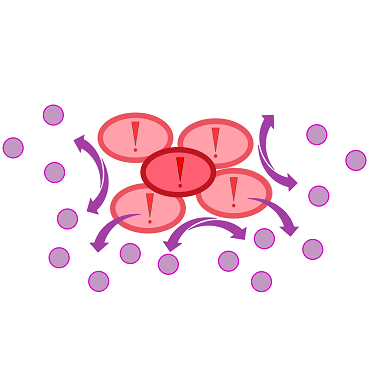Team:Aachen/Project/2D Biosensor
From 2014.igem.org
Aschechtel (Talk | contribs) (→Detecting 3-oxo-C{{sub|12}} HSL with sensor chips) |
Aschechtel (Talk | contribs) (→Detecting the 3-oxo-C{{sub|12}} HSL with K131026 in our sensor chip with WatsOn) |
||
| Line 167: | Line 167: | ||
{{Team:Aachen/FigureFloat|Aachen_K131026_HSLdetection_slow.gif|title=Detection of 3-oxo-C{{sub|12}} HSL with K131026|subtitle=0,2 µl of 3-oxo-C{{sub|12}} HSL were put in the middle of the chip and then incubated at 37 °C in our WatsOn device.|width=480px}} | {{Team:Aachen/FigureFloat|Aachen_K131026_HSLdetection_slow.gif|title=Detection of 3-oxo-C{{sub|12}} HSL with K131026|subtitle=0,2 µl of 3-oxo-C{{sub|12}} HSL were put in the middle of the chip and then incubated at 37 °C in our WatsOn device.|width=480px}} | ||
| - | The next step for the eventual goal to detect ''Pseudomonas aeruginosa'' was to replicate the detection of 3-oxo-C{{sub|12}} HSL, which was established in the platereader, in our own [https://2014.igem.org/Team:Aachen/Project/Measurement_Device WatsOn] device. Therefore we again used K131026 as our construct in ''E. coli'' BL21(DE3) cells and induced with 0 | + | The next step for the eventual goal to detect ''Pseudomonas aeruginosa'' was to replicate the detection of 3-oxo-C{{sub|12}} HSL, which was established in the platereader, in our own [https://2014.igem.org/Team:Aachen/Project/Measurement_Device WatsOn] device. Therefore we again used K131026 as our construct in ''E. coli'' BL21(DE3) cells and induced with 0.2 µl 3-oxo-C{{sub|12}} HSL with a concentration of 500 µg/ml. The right chip was induced and the left chip was not induced as a negative control. Pictures were taken every 4 minutes. |
The result clearly replicated the success of the platereader experiment. The induced chip shows a clear fluorescence response eminating from the center where the induction with HSL took place. This demonstrates the ability of not only our sensor chips but also our measurement device WatsOn to successfully detect 3-oxo-C{{sub|12}} HSL which is produced by ''Pseudomonas aeruginosa''. | The result clearly replicated the success of the platereader experiment. The induced chip shows a clear fluorescence response eminating from the center where the induction with HSL took place. This demonstrates the ability of not only our sensor chips but also our measurement device WatsOn to successfully detect 3-oxo-C{{sub|12}} HSL which is produced by ''Pseudomonas aeruginosa''. | ||
Revision as of 12:01, 16 October 2014
|
|
|
|
|
 "
"





